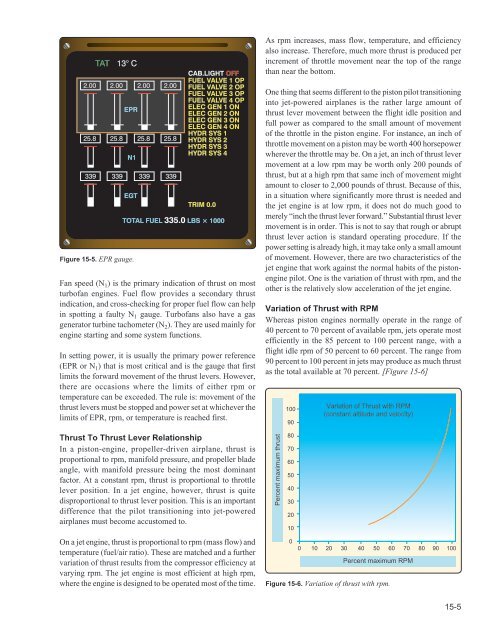You also want an ePaper? Increase the reach of your titles
YUMPU automatically turns print PDFs into web optimized ePapers that Google loves.
TAT<br />
13° C<br />
2.00 2.00 2.00 2.00<br />
EPR<br />
25.8 25.8 25.8 25.8<br />
N1<br />
339 339 339 339<br />
EGT<br />
Figure 15-5. EPR gauge.<br />
CAB.LIGHT OFF<br />
FUEL VALVE 1 OP<br />
FUEL VALVE 2 OP<br />
FUEL VALVE 3 OP<br />
FUEL VALVE 4 OP<br />
ELEC GEN 1 ON<br />
ELEC GEN 2 ON<br />
ELEC GEN 3 ON<br />
ELEC GEN 4 ON<br />
HYDR SYS 1<br />
HYDR SYS 2<br />
HYDR SYS 3<br />
HYDR SYS 4<br />
TRIM 0.0<br />
TOTAL FUEL 335.0 LBS × 1000<br />
Fan speed (N 1 ) is the primary indication of thrust on most<br />
turbofan engines. Fuel flow provides a secondary thrust<br />
indication, and cross-checking for proper fuel flow can help<br />
in spotting a faulty N 1 gauge. Turbofans also have a gas<br />
generator turbine tachometer (N 2 ). They are used mainly for<br />
engine starting and some system functions.<br />
In setting power, it is usually the primary power reference<br />
(EPR or N 1 ) that is most critical and is the gauge that first<br />
limits the forward movement of the thrust levers. However,<br />
there are occasions where the limits of either rpm or<br />
temperature can be exceeded. The rule is: movement of the<br />
thrust levers must be stopped and power set at whichever the<br />
limits of EPR, rpm, or temperature is reached first.<br />
Thrust To Thrust Lever Relationship<br />
In a piston-engine, propeller-driven airplane, thrust is<br />
proportional to rpm, manifold pressure, and propeller blade<br />
angle, with manifold pressure being the most dominant<br />
factor. At a constant rpm, thrust is proportional to throttle<br />
lever position. In a jet engine, however, thrust is quite<br />
disproportional to thrust lever position. This is an important<br />
difference that the pilot transitioning into jet-powered<br />
airplanes must become accustomed to.<br />
On a jet engine, thrust is proportional to rpm (mass flow) and<br />
temperature (fuel/air ratio). These are matched and a further<br />
variation of thrust results from the compressor efficiency at<br />
varying rpm. The jet engine is most efficient at high rpm,<br />
where the engine is designed to be operated most of the time.<br />
As rpm increases, mass flow, temperature, and efficiency<br />
also increase. Therefore, much more thrust is produced per<br />
increment of throttle movement near the top of the range<br />
than near the bottom.<br />
One thing that seems different to the piston pilot transitioning<br />
into jet-powered airplanes is the rather large amount of<br />
thrust lever movement between the flight idle position and<br />
full power as compared to the small amount of movement<br />
of the throttle in the piston engine. For instance, an inch of<br />
throttle movement on a piston may be worth 400 horsepower<br />
wherever the throttle may be. On a jet, an inch of thrust lever<br />
movement at a low rpm may be worth only 200 pounds of<br />
thrust, but at a high rpm that same inch of movement might<br />
amount to closer to 2,000 pounds of thrust. Because of this,<br />
in a situation where significantly more thrust is needed and<br />
the jet engine is at low rpm, it does not do much good to<br />
merely “inch the thrust lever forward.” Substantial thrust lever<br />
movement is in order. This is not to say that rough or abrupt<br />
thrust lever action is standard operating procedure. If the<br />
power setting is already high, it may take only a small amount<br />
of movement. However, there are two characteristics of the<br />
jet engine that work against the normal habits of the pistonengine<br />
pilot. One is the variation of thrust with rpm, and the<br />
other is the relatively slow acceleration of the jet engine.<br />
Variation of Thrust with RPM<br />
Whereas piston engines normally operate in the range of<br />
40 percent to 70 percent of available rpm, jets operate most<br />
efficiently in the 85 percent to 100 percent range, with a<br />
flight idle rpm of 50 percent to 60 percent. The range from<br />
90 percent to 100 percent in jets may produce as much thrust<br />
as the total available at 70 percent. [Figure 15-6]<br />
Percent maximum thrust<br />
100<br />
90<br />
80<br />
70<br />
60<br />
50<br />
40<br />
30<br />
20<br />
10<br />
0<br />
Variation of Thrust with RPM<br />
(constant altitude and velocity)<br />
0 10 20 30 40 50 60 70 80 90 100<br />
Percent maximum RPM<br />
Figure 15-6. Variation of thrust with rpm.<br />
15-5


